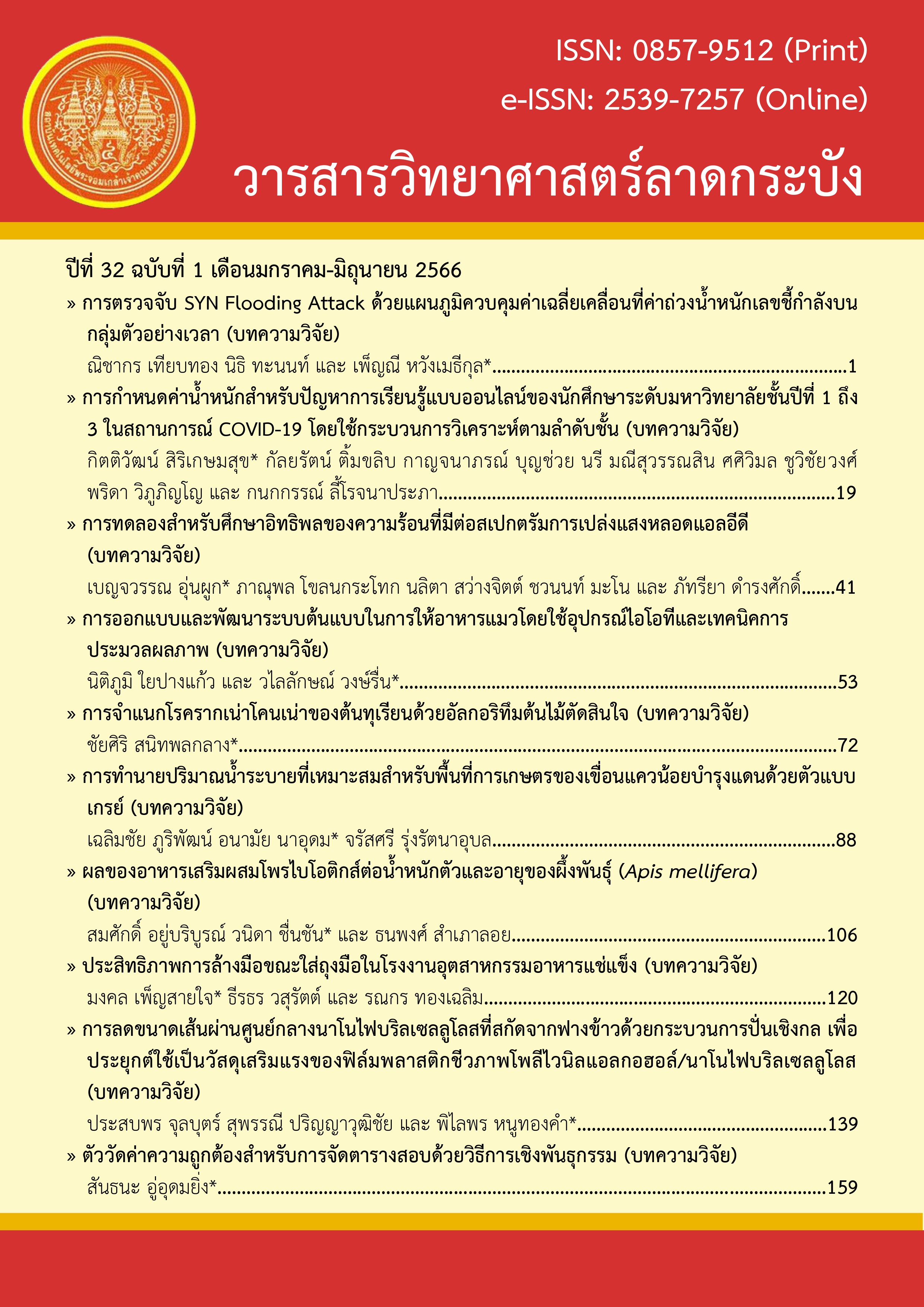ผลของอาหารเสริมผสมโพรไบโอติกส์ต่อน้ำหนักตัวและอายุของผึ้งพันธุ์ (Apis mellifera)
Main Article Content
บทคัดย่อ
งานวิจัยนี้มีวัตถุประสงค์เพื่อศึกษาผลของอาหารเสริมผสมโพรไบโอติกส์ต่อน้ำหนักตัวและอายุของผึ้งพันธุ์ (Apis mellifera) โดยใช้เชื้อแบคทีเรียโพรไบโอติกส์จำนวน 4 ชนิด ได้แก่ Lactobacillus casei TISTR 390, L. plantarum TISTR 541, L. curvatus TISTR 938 และ L. acidophilus TISTR 2365 หาน้ำหนักตัวของผึ้งด้วยวิธีการสุ่มชั่งน้ำหนักผึ้งงานจำนวน 100 ตัวต่อรัง โดยทำการทดลองละ 5 รัง และนำมาหาค่าเฉลี่ยของน้ำหนักผึ้งต่อ 1 ตัว โดยสุ่มตั้งแต่ผึ้งเริ่มออกจากหลอดรวงที่สร้างทุกสัปดาห์ เป็นเวลา 8 สัปดาห์ หาอายุของผึ้งด้วยวิธีการแต้มสี acrylic ที่บริเวณส่วนอกของผึ้งงานที่เกิดใหม่จำนวน 300 ตัวต่อรัง โดยทำการทดลองละ 5 รัง และนับจำนวนผึ้งงานที่ทำเครื่องหมายไว้ทุกวันเป็นเวลา 80 วัน เพื่อหาค่าเฉลี่ยอายุผึ้งงาน จากการทดลองพบว่า ในสัปดาห์สุดท้ายของการวิจัย ผึ้งงานที่เลี้ยงด้วยอาหารตามธรรมชาติมีน้ำหนักเฉลี่ยมากที่สุด (113.76 ± 24.88 มิลลิกรัม) แตกต่างกับชุดการทดลองอื่นอย่างมีนัยสำคัญ รองลงมาคือผึ้งงานที่เลี้ยงด้วยอาหารเสริมผสม L. casei (101.36 ± 15.23 มิลลิกรัม) L. curvatus (96.78 ± 12.69 มิลลิกรัม) L. plantarum (95.66 ± 15.29 มิลลิกรัม) L. acidophilus (93.52 ± 14.61 มิลลิกรัม) และผึ้งงานที่เลี้ยงด้วยอาหารเสริมที่ไม่ได้ผสมโพรไบโอติกส์ (92.62 ± 12.84 มิลลิกรัม) ตามลำดับ [F (5, 144) = 5.729, p≤0.05] และจากการหาค่าเฉลี่ยอายุของผึ้งงานพบว่า อายุของผึ้งงานที่ได้รับโพรไบโอติกส์มีความแตกต่างอย่างมีนัยสำคัญกับอายุของผึ้งงานที่ไม่ได้รับโพรไบโอติกส์ โดยผึ้งงานที่ได้รับ L. plantarum มีอายุเฉลี่ยสูงสุดเท่ากับ 68.60 ± 0.707 วัน รองลงมาคือผึ้งงานที่ได้รับ L. acidophilus (67.60 ± 0.548 วัน) L. casei (67.40 ± 0.548 วัน) L. curvatus (66.80 ± 0.447 วัน) ผึ้งงานที่เลี้ยงด้วยอาหารเสริมที่ไม่ได้ผสมโพรไบโอติกส์ (51.80 ± 0.447 วัน) และผึ้งงานที่เลี้ยงด้วยอาหารตามธรรมชาติ (42.60 ± 0.548 วัน) ตามลำดับ [F (5, 24) = 2245.80, p≤0.05] งานวิจัยนี้บ่งชี้ว่าโพรไบโอติกส์ทั้ง 4 ชนิด สามารถนำไปพัฒนาเป็นส่วนผสมในผลิตภัณฑ์อาหารเสริมสำหรับส่งเสริมอายุของผึ้งพันธุ์ได้
Article Details

อนุญาตภายใต้เงื่อนไข Creative Commons Attribution-NonCommercial-NoDerivatives 4.0 International License.
เอกสารอ้างอิง
Kjohl, M., Nielsen, A., and Stenseth, N.C. 2011. Potential effects of climate change on crop pollination. Food and Agriculture Organization of the United Nations, Rome, 38p.
Sauthier, R., Price, R.I.A. and Gruter, C. 2017. Worker size in honeybees and its relationship with season and foraging distance. Apidologie, 48, 234–246. doi: 10.1007/s13592-016-0468-0.
Anderson, K.E., Sheehan, T.H., Eckholm, B.J., Mott, B.M. and De Grandi-Hoffman G. 2011. An emerging paradigm of colony health: microbial balance of the honey bee and hive (Apis mellifera). Insectes Sociaux, 58, 431. doi:10.1007/s00040-011-0194-6.
Syromyatnikov, M.Y., Isuwa, M.M., Savinkova, O.V., Derevshchikova, M.I. and Popov, V.N. 2020. The effect of pesticides on the microbiome of animals. Agriculture, 10(3), 79-92. doi:10.3390/agriculture10030079.
สิริวัฒน์ วงษ์ศิริ และนิคม โคตรสุวรรณ. 2562. บทความพิเศษชุด : ความหวานและอำนาจ-หอบรัง ผึ้งหาแหล่งความหวาน (2), แหล่งข้อมูล https://theisaanrecord.co/2019/09/20/sweetness-and-power-part-12-th/. ค้นเมื่อวันที่ 10 กรกฎาคม 2565. [Sirieat Wongsiri, and Nikhom Khotsuwan. 2019. Special articles: Sweetness and power-gather up the hive for sweet source (2), from https://theisaanrecord.co/2019/09/20/sweetness-and-power-part-12-th/. Retrieved July 10, 2022. (in Thai)]
ภาณุวรรณ จันทรวรรณกูร, วรรณจันทร์ แสงหิรัญ ลี, ปิยรัตน์ นิมมานพิภักดิ์ และศศิประภา ครองแดง. 2561. ผึ้ง สารฆ่าแมลง ผลกระทบต่อระบบนิเวศ และสุขภาพของมนุษย์. แม็กซ์ปริ้นติ้ง, เชียงใหม่. [Panuwan Chantawannakul, Vannajan Sanghiran Lee, Piyarat Nimmanpipug, and Sasiprapa Krongdang. 2018. Bee, pesticide, the impact on ecosystem and human health. MaxxPRINTINGTM, Chiangmai. (in Thai)]
Mountzouris, K., Tsitrsikos, P., Palamidi, I., Arvaniti, A., Mohnl, M., Schatzmayr, G. and Fegeros, K. 2010. Effects of probiotic inclusion levels in broiler nutrition on growth performance, nutrient digestibility, plasma immunoglobulins, and cecal microflora composition. Poultry Science, 89(1), 58-67. doi:103382/ps.2009-00308.
ชัยวัฒน์ ไชยสุต. 2554. โพรไบโอติก : จุลินทรีย์เพื่อชีวิต. อินฟินิตี้ คัลเลอร์ พริ้นติ้ง, กรุงเทพฯ.[Chaiwat Chaiyasut. 2011. Probiotics: microorganisms for life. Infinity color Printing, Bangkok. (in Thai)]
De Man, J.C., Rogosa, M. and Sharpe, M.E. 1960. A medium for the cultivation of lactobacilli. Journal of Applied Bacteriology, 23, 130-135.
Meidong, R., Khotchanalekha, K., Doolgindachbaporn, S., Nagasawa, T., Nakao, M., Sakai, K. and Tongpim, S. 2017. Evaluation of probiotic Bacillus aerius B81e isolated from healthy hybrid catfish on growth, disease resistance and innate immunity of Pla-mong Pangasius bocourti. Fish & Shellfish Immunology, 73, 1-10.
Coeuret, V., Gueguen M. and Vernoux J.P. 2004. Numbers and strains of lactobacilli in some probiotic products. International Journal of Food Microbiology, 97, 147-56.
Human, H., Brodschneider, R., Dietemann, V., Dively, G., Ellis, J.D., Forsgren, E., Fries, I., Hatjina, F., Hu, F.L., Jaffe, R., Jensen, A.B., Köhler, A., Magyar, J.P., Ozkýrým, A., Pirk, C.W.W., Rose, R., Strauss, U., Tanner, G., Tarpy, D.R., van der Steen, J.J.M., Vaudo, A., Vejsnæs, F., Wilde, J., Williams, G.R. and Zheng, H.Q. 2013. Miscellaneous standard methods for Apis mellifera research. Journal of Apicultural Research, 5(4), 1-53. doi: 10.3896/IBRA.1.52.4.10.
Giovanetti, M. and Lasso, E. 2005. Body size, loading capacity and rate of reproduction in the communal bee Andrena agilissima (Hymenoptera; Andrenidae). Apidologie, 36(3), 439-447.
Behrends, A. and Scheiner, R. 2010. Learning at old age: a study on winter bees. Frontiers in Behavioral Neuroscience. 4(15), 1-11. doi:10.3389/fnbeh.2010.00015.
Greenleaf, S.S., Williams, N.M., Winfree, R. and Kremen, C. 2007. Bee foraging ranges and their relationship to body size. Oecologia, 153(3), 589-596. doi: 10.1007/s00442-007-0752-9.
Di Pasquale, G., Salignon, M., Conte, Y.L., Belzunces, L.P., Decourtye, A., Kretzschmar, A., Suchail, S., Brunet, J.L. and Alaux, C. 2013. Influence of pollen nutrition on honey bee health: Do pollen quality and diversity matter? PLoS ONE, 8(8), e72016. doi:10.1371/journal.pone.0072016.
Frias, B.E.D., Barbosa, C. and Lourenco, A.P. 2016. Pollen nutrition in honey bees (Apis mellifera): impact on adult health. Apidologie, 47, 15–25. doi: 10.1007/s13592-015-0373-y.
Mc Mullan, J.B. and Brown, M.J.F. 2006. The influence of small-cell brood combs on the morphometry of honeybees (Apis mellifera). Apidologie, 37(6), 665-672. doi: 10.1051/apido:2006041.
Slater, G. 2017. Comb management part 2: Comb size., Available at: https://beeinfo rmed.org/2017/11/03/comb-management-part2-comb-size/ Retrieved July 10, 2022.
Eyer, M., Dainat, B., Neumann, P. and Dietemann, V. 2017. Social regulation of ageing by young workers in the honey bee, Apis mellifera. Experimental Gerontology, 87(Pt A), 84–91. doi:10.1016/j.exger.2016.11.006.
Gillespie, C. 2018. What is the life Span of a honey bee? Available at: https://scienc ing.com/ life-span-honey-bee-6573678.html. Retrieved April 13, 2021.
Chen, Y.W., Hwang, G.Y. and Ho, K.K. 2000. Susceptibility of the asian honey bee Apis cerana to american foulbrood Paenibacillus larvae. Journal of Apicultural Research, 39(1), 169-175.
Corby-Harris, V., Maes, P. and Anderson, K.E. 2014. The bacterial communities associated with honey bee (Apis mellifera) foragers. PLoS ONE, 9(4), e95056. doi:10.1371/journal.pone.0095056.
Corby-Harris, V., Snyder, L., Meador, C.A.D., Naldo, R., Mott, B. and Anderson, K.E. 2016. Parasaccharibacter apium, gen. nov., sp. nov., improves honey bee (Hymenoptera: Apidae) resistance to Nosema. Journal of Economic Entomology, 109(2), tow012.doi:10.1093/jee/tow012: 1-7.
Patruica, S. and Hutu, I. 2013. Economic benefits of using prebiotic and probiotic products as supplements in stimulation feeds administered to bee colonies. Turkish Journal of Veterinary and Animal Sciences, 37(3), 259-263. doi:10.3906/vet-1110-20.
Münch, D., Kreibich, C.D. and Amdam, G.V. 2013. Aging and its modulation in a long-lived worker caste of the honey bee. Journal of Experimental Biology, 216(Pt9), 1638-1649. doi:10.1242/jeb.078915.

